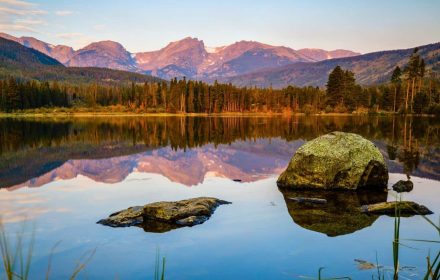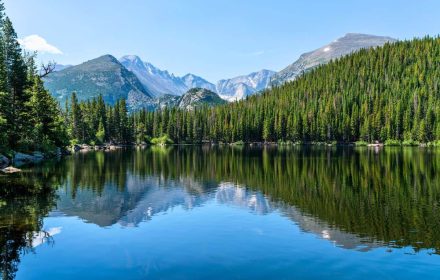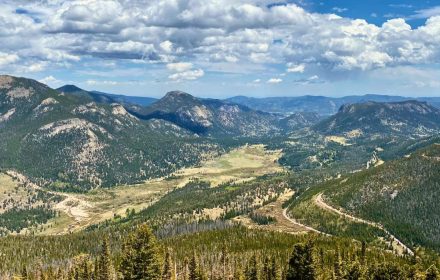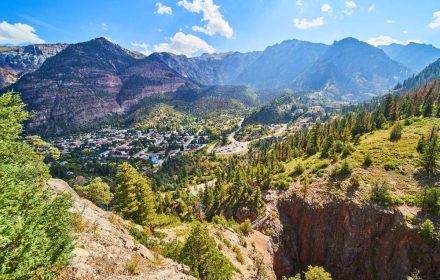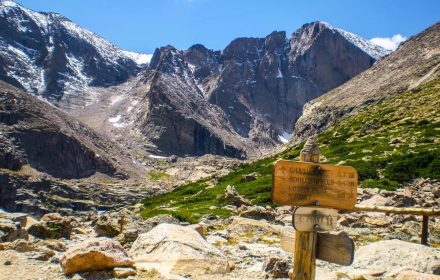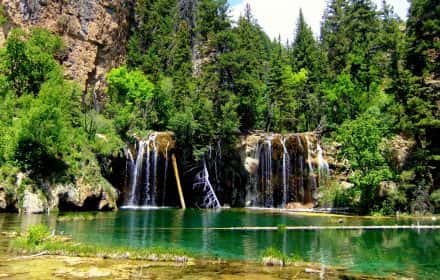This site uses affiliate links, meaning that if you make a purchase through our links, we may earn an affiliate commission.
Rocky Mountain National Park is an incredible spot, packed with everything from mountain peaks and alpine lakes to scenic drives and wildlife. If it’s your first time visiting, you’re in for a treat!
But, with the park’s popularity and diverse landscapes, there are some important things to know before you go to make sure your experience is smooth and enjoyable. Here’s a guide packed with tips for first-time visit to Rocky Mountain National Park to help you make the most of your adventure.
- 1. Where is Rocky Mountain National Park and How to Get There
- 2. How to Get Around in the Park
- 3. Rocky Mountain National Park Entry Fees and Timed Entry Permits
- 4. Best Time to Visit RMNP
- 5. Park Entrances
- 6. Where to Stay Based on Each Entrance
- 7. Dealing with High Altitude
- 8. Best Hikes for a First-Time Visit to Rocky Mountain National Park
- 9. Trail Ridge Road: A Must-See Drive Through the Rockies
- 10. What to Pack for Your Visit
- 11. Wildlife Safety in Rocky Mountain National Park
- 12. Photography Tips for Rocky Mountain National Park
- 13. Camping at Rocky Mountain National Park
Where is Rocky Mountain National Park and How to Get There
Rocky Mountain National Park (RMNP) is located in northern Colorado, close to the town of Estes Park on the east side and Grand Lake on the west side.
It’s about 70 miles northwest of Denver, making it a popular and accessible spot for day trips and longer stays.
The park spans the Continental Divide, covering over 265,000 acres of mountains, forests, and alpine tundra.
- Driving from Denver:
From Denver, RMNP is about a 1.5- to 2-hour drive, depending on traffic and the route you take. The most direct route to Estes Park and the east entrances is via Highway 36, which takes you through Boulder.
Alternatively, you can take I-25 north to Highway 34 through Loveland, which also leads to Estes Park. Both routes offer scenic views, but traffic can be heavy during peak times, so plan for early mornings if possible.
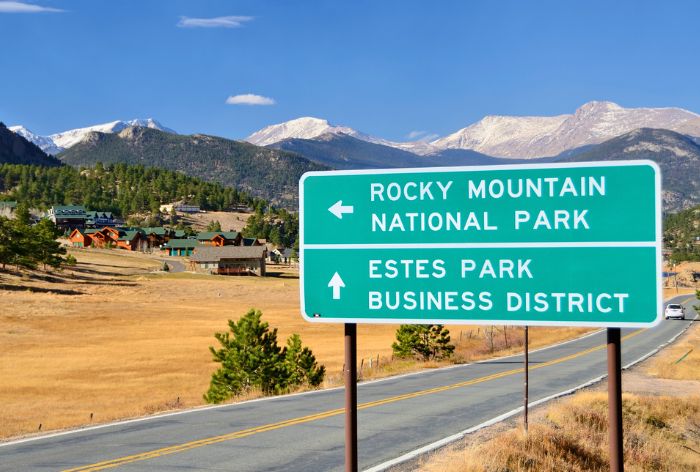
Road to RMNP / Tips for Firs-Time Visit to Rocky Mountain National Park
- Flying In:
The closest major airport is Denver International Airport (DEN). From there, renting a car is your best option for reaching the park, as public transportation options are limited.
- Getting to the West Side:
To access the park’s quieter west side and Grand Lake area, you can drive from Denver via I-70 west to US-40 north over Berthoud Pass. This route takes about 2.5 hours and offers an entirely different perspective of the Rockies. Although farther from major cities, the west side provides a more relaxed experience with fewer crowds.
How to Get Around in the Park
- Driving Your Vehicle
Driving is the most flexible way to get around RMNP, however, parking at trailheads can fill up quickly.
If you’re heading to popular areas along Bear Lake Road and Trail Ridge Road, try to arrive early (before 8 a.m.) to secure a spot.
The roads in RMNP can be narrow, winding, and sometimes steep, especially on Trail Ridge Road, which reaches over 12,000 feet in elevation. This road provides breathtaking views but requires careful driving, particularly in wet or icy conditions.
Remember to check for seasonal closures on Trail Ridge Road, as it’s typically open from late May to early October, depending on the weather.
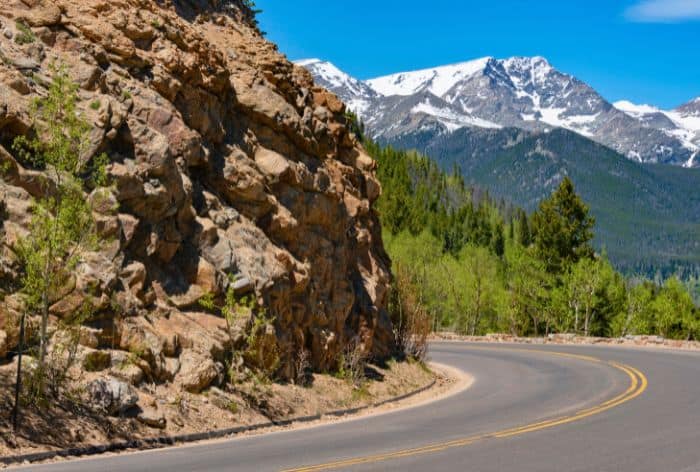
Trail Ridge Road / Tips for First-Time Visit to Rocky Mountain National Park
- Using the Shuttle System
If you prefer to avoid parking hassles, RMNP offers a convenient shuttle system that makes exploring the Bear Lake area easy and eco-friendly.
Here’s how the main shuttle routes work:
Bear Lake Shuttle: This shuttle runs frequently, every 10-15 minutes, starting from 6:30 a.m. It connects the Park & Ride Transit Hub near Glacier Basin Campground with popular stops such as Bierstadt Lake Trailhead, Glacier Gorge Trailhead, and Bear Lake itself. The last shuttle back from Bear Lake leaves around 7:30 p.m., so plan your hikes with the return time in mind to avoid missing the last bus.
Moraine Park Shuttle: This route operates every 30 minutes, also from 6:30 a.m. to 7:30 p.m. It services areas like Sprague Lake and Fern Lake, making it a great option for visitors looking to explore more serene spots outside the busiest areas.
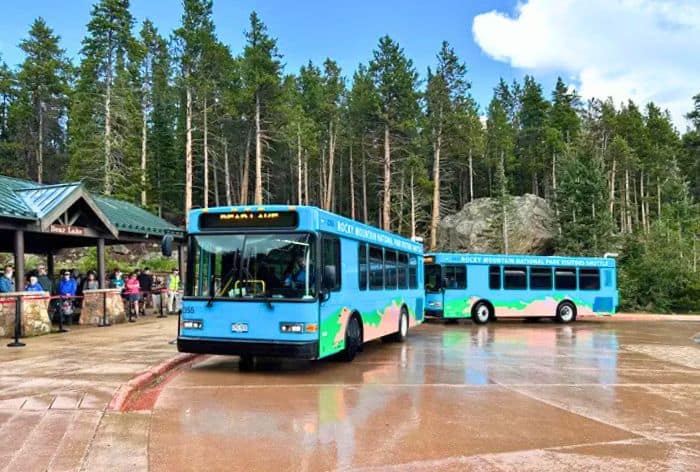
Shuttle in Rocky Mountain / Tips for First-Time Visit to Rocky Mountain National Park
GOOD TO KNOW: If you are staying in Estes Park, there is a Hiker Shuttle that connects the Estes Park Visitor Center to the Park & Ride Transit Hub on Bear Lake Road. It is a convenient link to the Bear Lake area without needing to drive into the park, especially useful if parking fills up early during peak times.
Rocky Mountain National Park Entry Fees and Timed Entry Permits
To access Rocky Mountain National Park, you’ll need a valid park pass. There are several options depending on the length of your visit:
- Daily Pass: $35 per vehicle (valid for one day)
- Weekly Pass: $35 per vehicle (valid for 7 days)
- Annual Pass: $70 for unlimited visits for one year (America the Beautiful Pass)
During the peak season (May-October), Rocky Mountain National Park requires a timed-entry permit for Bear Lake Road and Trail Ridge Road between 5 a.m. and 6 p.m.
You’ll need to reserve a time slot in advance through the Recreation.gov website.
GOOD TO KNOW: There are two main options for entry:
- Bear Lake Corridor Permit – Includes Bear Lake Road and the rest of the park.
- Park Access, No Bear Lake Road Permit – Allows access to the rest of the park but excludes Bear Lake Road.
Permits are released in two phases: one month in advance, and a limited number are available at 5 p.m. the day before. It’s highly recommended to book your permit as early as possible during peak months.
Best Time to Visit RMNP
Timing your visit right can make a huge difference! The park is open year-round, but each season brings its own vibe and challenges.
Here’s what to expect each season:
- Summer (June to early September):
This is peak season, with all roads open, including the popular Trail Ridge Road. The park is bustling, so aim for an early morning arrival to find parking and avoid crowds.
Afternoon thunderstorms are common, so hiking earlier in the day is often ideal. Wildlife is abundant, and wildflowers blanket the higher elevations, making it perfect for sightseeing and accessible hikes.
- Fall (September to October):
Known for its brilliant autumn colors and the elk rutting season, fall is a great time to see wildlife and enjoy cooler weather.
While days are usually warm and clear, early snowfall can close higher-elevation areas, particularly in late October when Trail Ridge Road typically shuts for the season. Visiting mid-week in September is ideal for fewer crowds, as weekends remain busy into October.
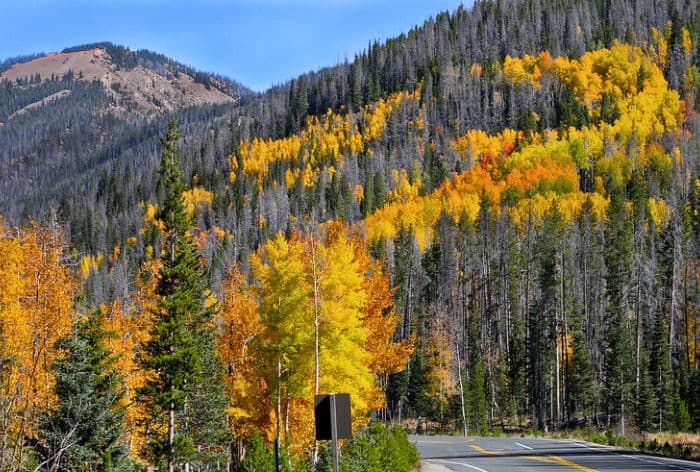
Fall Colors in RMNP / Tips for First-Time Visit to Rocky Mountain National Park
- Winter (November to March):
With a quiet, snow-covered landscape, winter offers opportunities for activities like snowshoeing, sledding, and cross-country skiing.
However, conditions can be harsh, with heavy snow and wind on the west side and clear but icy days on the east. Although access is limited, you can still drive the first few miles of Trail Ridge Road to Many Parks Curve overlook for stunning winter scenery
- Spring (April to mid-June):
Spring is unpredictable, with fluctuating snow and mud on trails, especially in the higher regions.
April can be quiet with fewer visitors, making it ideal for spotting wildlife emerging from hibernation. By May, wildflowers start blooming, though snow may linger in alpine areas until summer officially kicks in.
Park Entrances
Rocky Mountain National Park (RMNP) has four main entrances, each offering unique access points to different parts of the park.
Here’s a breakdown of each entrance to help you decide the best starting point for your visit:
- Beaver Meadows Entrance
The Beaver Meadows Entrance is the main entrance to RMNP, located off Highway 36, just a few miles from Estes Park.
This is the busiest entrance, and for good reason: it provides quick access to popular areas like Bear Lake Road and Trail Ridge Road. From here, visitors can easily reach famous trails like Bear Lake and Dream Lake, as well as scenic drives that showcase RMNP’s incredible mountain views.
PRO TIP: Keep in mind that lines can get long here, especially during peak summer months, so arriving early can help you avoid the crowds.
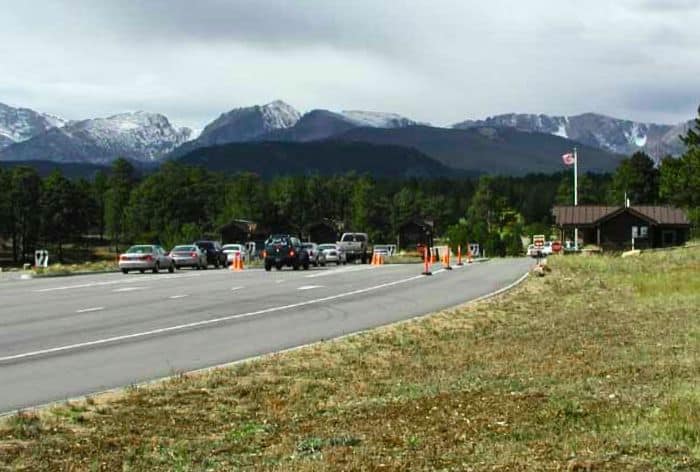
Beaver Meadows Entrance to RMNP / Tips for First-Time Visit to Rocky Mountain National Park
- Fall River Entrance
The Fall River Entrance, also near Estes Park off Highway 34, offers another convenient entry to the eastern side of the park.
It’s a bit less crowded than Beaver Meadows but still provides easy access to major sites, including Trail Ridge Road and Horseshoe Park, a prime wildlife-viewing area.
GOOD TO KNOW: If you’re looking to explore the scenic Old Fall River Road (open seasonally), this entrance gives you the quickest route. This is also a good alternative for those staying on the north side of Estes Park, as it’s often a bit quieter than Beaver Meadows.
- Wild Basin Entrance
The Wild Basin Entrance is the least-trafficked of the park’s main entrances, located south of Estes Park off Highway 7.
This area is more remote and has limited parking, but it’s a hidden gem for those seeking a quieter experience and beautiful backcountry trails.
Wild Basin features waterfalls, serene lakes, and lush forested paths that are perfect for escaping the crowds.
GOOD TO KNOW: The entrance has limited amenities, so make sure you’re prepared if you choose to explore this area.
- Grand Lake Entrance
On the western side of RMNP, the Grand Lake Entrance offers a different perspective of the park.
Located off Highway 34 near the town of Grand Lake, this entrance is ideal for visitors coming from the west or those looking to enjoy a quieter side of RMNP.
From here, you can access the western terminus of Trail Ridge Road and see incredible views over the Continental Divide.
The Grand Lake area is known for its serene alpine lakes and diverse wildlife, with fewer crowds than Estes Park’s entrances. It’s also a great spot for those interested in backcountry camping or fishing.
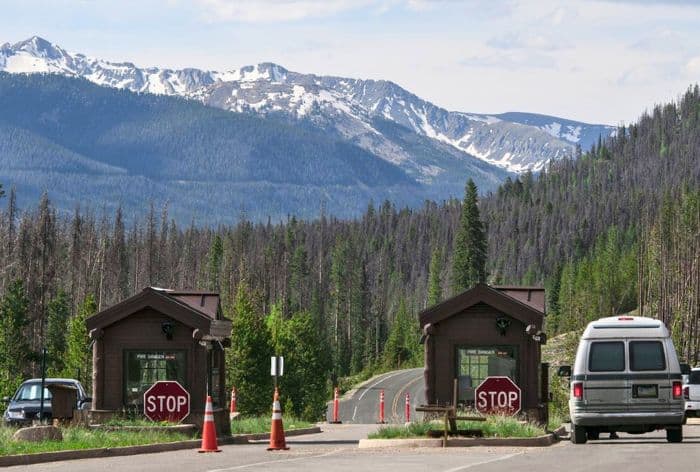
Grand Lake Entrance / Tips for First-Time Visit to Rocky Mountain National Park
Where to Stay Based on Each Entrance
Here’s a guide to where to stay near each entrance to Rocky Mountain National Park (RMNP):
- Beaver Meadows Entrance (East Side, Near Estes Park)
The Beaver Meadows Entrance, one of the park’s busiest, is just minutes from the town of Estes Park, which has the widest variety of accommodations.
One of my favorite places is The Estes Park Resort set right on the shores of Lake Estes. It is great place to unwind after a day in the park. The rooms are cozy and comfortable, with lake views, and there’s an onsite restaurant if you’re looking to grab a meal with a view.
Another place that I stayed at is Rams Horn Village Resort. Located just a mile from the main entrance, it offers private cabins with full kitchens, fireplaces, and patios, so it’s easy to feel at home. The resort has perks like a heated pool, hot tubs, and a fitness room. Plus, it’s close to downtown Estes Park for quick access to restaurants and shops, making it super convenient for a relaxing, fun stay.
- Fall River Entrance (East Side, Near Estes Park)
The Fall River Entrance, also near Estes Park, is quieter than Beaver Meadows but still close to town amenities.
The Inn on Fall River & Fall River Cabins is set along the Fall River. It offers riverside cabins with fireplaces and private hot tubs. It’s ideal for couples or families looking for a more secluded place close to the park.
- Wild Basin Entrance (Southeast Side)
The Wild Basin Entrance, south of Estes Park, is ideal for visitors seeking a more secluded experience and access to quiet trails.
My first choice is Taharaa Mountain Lodge. Though it’s about a 20-minute drive to Wild Basin, Taharaa offers beautiful mountain views and a more upscale, romantic experience with luxurious rooms, suites, and gourmet dining.
- The Grand Lake Entrance
The Grand Lake Entrance provides access to the park’s quieter side, near the lakeside town of Grand Lake.
Gateway Inn is located just minutes from the Grand Lake Entrance. This rustic mountain lodge offers rooms with lake or mountain views and a cozy bar area with a fireplace. It’s perfect for couples or families wanting easy access to RMNP with the convenience of staying in town.
Dealing with High Altitude
Rocky Mountain National Park is known for its high elevation, with many trails and points reaching well over 10,000 feet.
Trail Ridge Road even climbs up to 12,183 feet, putting visitors in a thin-air environment where altitude sickness is a real concern for many.
Here’s how to prepare for and manage the effects of high altitude.
- Understanding Altitude Sickness
Altitude sickness can happen when you ascend to high elevations too quickly. Symptoms can include headaches, dizziness, nausea, and shortness of breath.
The body needs time to adjust to the lower oxygen levels, so these symptoms are often more pronounced if you’re coming from a low-elevation area.
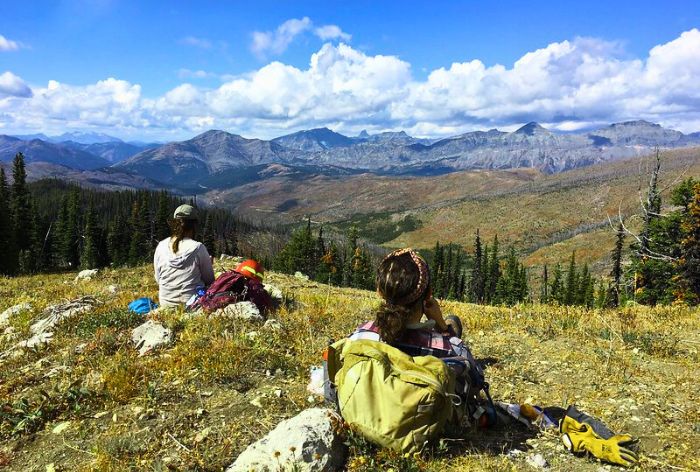
Acclimating to High Altitude / Tips for First-Time Visit o Rocky Mountain National Park
- Tips for Acclimating
Ascend Gradually: If possible, spend a day or two in Estes Park (7,522 feet) before tackling the higher areas in the park. This allows your body to begin adjusting to the elevation change before you reach the highest points.
Stay Hydrated: High altitudes are very dehydrating, so drink more water than you typically would.
Pace Yourself: Avoid strenuous activities, especially on the first day. Instead, start with shorter, easier hikes to let your body get used to the thinner air before tackling longer, steeper trails.
PRO TIP: If you’re especially concerned about altitude sickness, talk to your doctor about medications like acetazolamide (Diamox), which can help your body adapt to higher altitudes by speeding up acclimatization.
Best Hikes for a First-Time Visit to Rocky Mountain National Park
If it’s your first visit to Rocky Mountain National Park, picking the right hikes can make all the difference in your experience.
Here are some beginner-friendly trails that showcase the park’s iconic lakes, mountain views, and diverse ecosystems, perfect for getting a feel for RMNP’s stunning landscapes without taking on too much elevation or distance:
- Bear Lake Loop
Distance: 0.6 miles round trip
Elevation Gain: Minimal
Difficulty: Easy
This short loop around Bear Lake is ideal for all ages and fitness levels and gives a good taste of the park’s alpine scenery. Along the way, you’ll enjoy panoramic views of the lake with mountains reflecting off its surface, framed by the tall pines surrounding the trail. It’s especially beautiful in the early morning or at sunset.
PRO TIP: Bear Lake is very popular, so plan to arrive early to find parking, or take the shuttle from the Park & Ride during peak season.
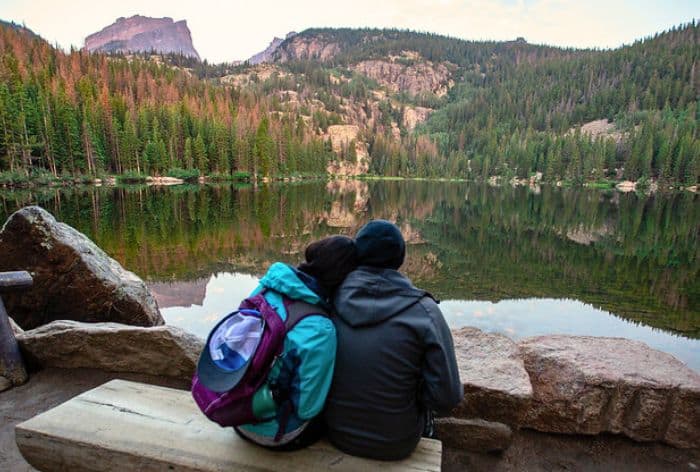
Bear Lake in RMNP / Tips for First-Time Visit to Rocky Mountain National Park
- Alberta Falls
Distance: 1.7 miles round trip
Elevation Gain: 200 feet
Difficulty: Easy to Moderate
Alberta Falls is one of the most popular hikes in the park for a reason! Starting from the Glacier Gorge Trailhead, this short and moderate hike leads you to a lovely waterfall cascading over smooth rocks. This trail is also shaded by aspens and pine trees, so it’s a refreshing hike on warmer days.
GOOD TO KNOW: This hike can be extended by continuing on to either Mills Lake or The Loch for a more challenging hike with breathtaking lake views.
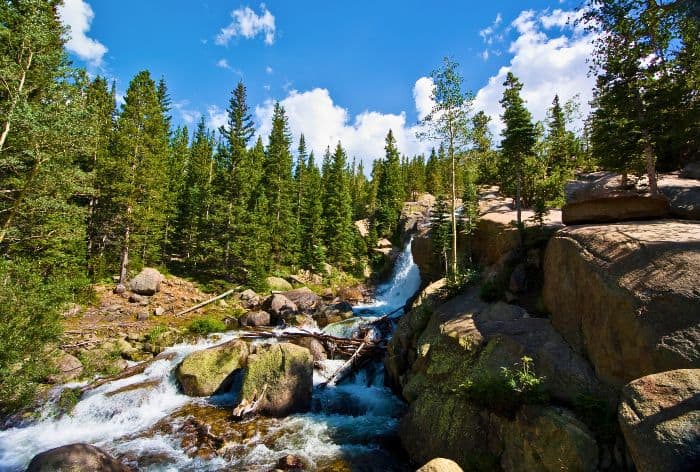
Alberta Falls / Tips for First-Time Visit to Rocky Mountain National Park
- Nymph, Dream, and Emerald Lakes
Distance: 3.5 miles round trip
Elevation Gain: 650 feet
Difficulty: Moderate
Starting at Bear Lake Trailhead, this trail takes you past three stunning alpine lakes, each with its own character. The first, Nymph Lake, is often dotted with water lilies. A bit further along is Dream Lake, known for its reflection of Flattop Mountain. At the end, you’ll reach Emerald Lake, tucked beneath towering cliffs.
This hike has moderate elevation gain but offers some of the best scenery in the park, making it a great introductory hike with incredible rewards for the effort.
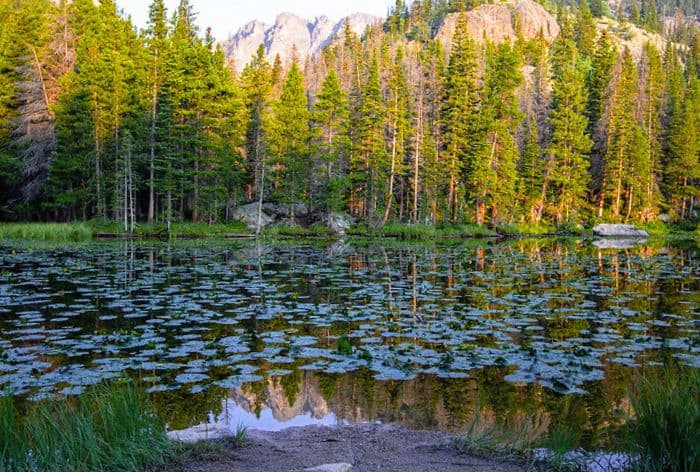
Dream Lake / Tips for First-Time Visit to Rocky Mountain
Trail Ridge Road: A Must-See Drive Through the Rockies
Trail Ridge Road is the crown jewel of Rocky Mountain National Park’s scenic drives, taking you across the Continental Divide and offering some of the most breathtaking mountain views in Colorado.
This 48-mile stretch connects Estes Park on the east side to Grand Lake on the west and is known as one of the highest continuous paved roads in North America, reaching a high point of 12,183 feet.
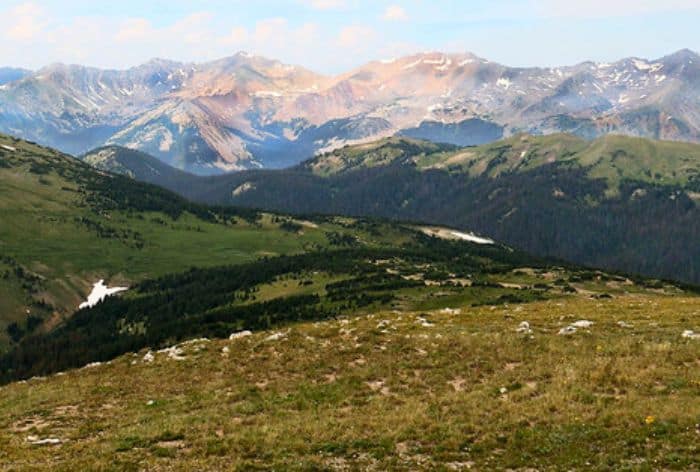
View from Trail Ridge Road / Tips for First-Time Visit to RMNP
Along the route, you’ll find numerous pullouts, each offering stunning views and opportunities for wildlife spotting, with sightings of elk, marmots, and even bighorn sheep. The road also passes several historical and geological points of interest, making it an educational journey as well as a scenic one.
The road is typically open from late May through October, depending on weather and snow conditions.
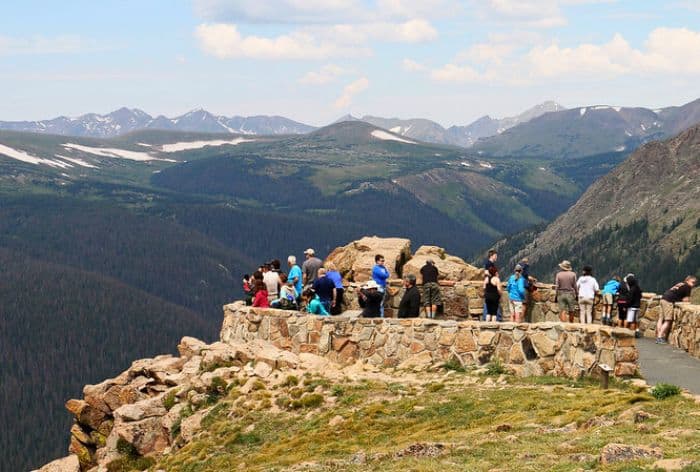
Trail Ridge Road / Tips for First-Time Visit to Rocky Mountain National Park
- Key Stops and Scenic Pullouts:
Rainbow Curve – At around 10,800 feet, this pullout offers panoramic views of Estes Park Valley and the surrounding mountains. I
Forest Canyon Overlook – This stop provides stunning views of Forest Canyon and the Never Summer Mountains, with interpretive signs explaining the unique alpine tundra ecosystem.
Rock Cut – This overlook offers views down the valley and a chance to walk along the Tundra Communities Trail, a short, paved trail with educational signs that highlight the fragile tundra environment.
What to Pack for Your Visit
Rocky Mountain National Park’s diverse weather and high altitude require thoughtful packing to ensure a comfortable and safe experience, especially if you’re visiting multiple areas with varying climates.
- Layered Clothing
The elevation in RMNP ranges from around 7,800 feet to over 12,000 feet, which means temperature swings of 20-30°F within the same day aren’t uncommon. Layering is key to managing these shifts.
- Essentials for Sun Protection
High-altitude sun exposure is intense, so bring sunglasses, a broad-brimmed hat, and sunscreen with a high SPF.
- Rain and Snow Gear
Even during summer, sudden thunderstorms are common in RMNP, especially in the afternoons. A light, packable rain jacket will help you stay dry without adding too much weight.
- Emergency Preparedness
A small first aid kit with essentials like band-aids, antiseptic, and pain relievers can be a lifesaver for minor injuries. High-altitude hikes increase the risk of minor falls, blisters, and altitude-related symptoms, so pack accordingly. A whistle and a basic multi-tool or pocket knife are also helpful in emergencies, especially if you’re hiking off the beaten path.
- Snacks for Energy
Pack nutrient-dense snacks like trail mix, protein bars, or dried fruit. These will keep your energy up during longer hikes.
Wildlife Safety in Rocky Mountain National Park
Rocky Mountain National Park (RMNP) provides a habitat for a wide range of animals, including elk, mule deer, bighorn sheep, black bears, mountain lions, and more. While these animals can be beautiful to observe, it’s crucial to keep safety in mind.
- Keep a Safe Distance
While it may be tempting to get close for a better photo or experience, getting too close can be dangerous for both you and the animals. The National Park Service advises the following distances:
Elk, Deer, Moose: At least 75 feet (about 23 meters). These animals can appear calm, but they are still wild and can become aggressive, especially during mating season or when they feel threatened.
Bighorn Sheep: Maintain a distance of at least 100 feet (30 meters). They are often found in steep areas and can be unpredictable.
Bears and Mountain Lions: Stay at least 120 feet (37 meters) away from these animals. Bears, especially black bears, can be attracted to food sources, and mountain lions are naturally more secretive but can become a threat if they feel cornered or threatened.

Moose in RMNP / Tips for First-Time Visit to Rocky Mountain National Park
- Proper Food Storage
Whether you’re hiking, camping, or picnicking, storing food properly is critical to preventing wildlife encounters.
In RMNP, bears are common, and attracting them with food can lead to dangerous situations. Never leave food unattended in vehicles or tents, as bears have been known to break into cars or tents to access food.
Photography Tips for Rocky Mountain National Park
Rocky Mountain National Park is a photographer’s paradise, with sweeping vistas, alpine lakes, and wildlife around every corner!
- Best Time for Photos
Golden hours, the periods shortly after sunrise and just before sunset offer the best lighting for photography.
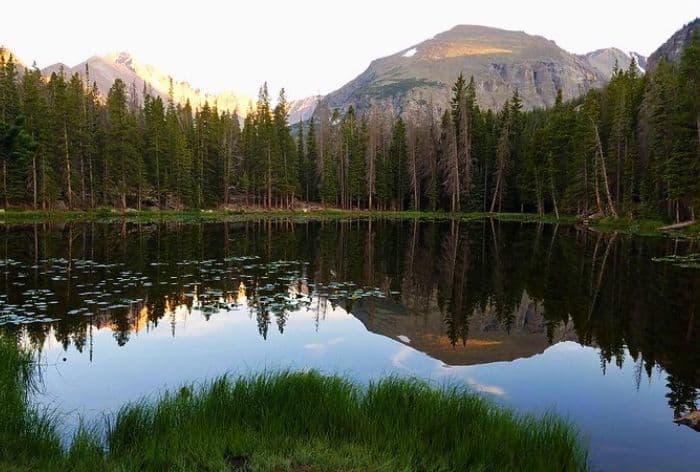
Sunset at Dream Lake / Tips for First-Time Visit to Rocky Mountain National Park
- Best Photography Spots
The park has countless scenic spots that are perfect for capturing its natural beauty. Some of the most photogenic locations include:
Bear Lake: This picturesque lake is one of the most popular spots in the park, and for good reason. Surrounded by mountains, Bear Lake offers stunning reflections, especially during calm mornings. A wide-angle lens works wonders here to capture the full scenery.
Sprague Lake: Another favorite for photographers, this lake offers a more serene and intimate setting. The view of the Continental Divide from Sprague Lake is particularly stunning, and the reflections are often perfect at sunrise or sunset.
Trail Ridge Road: This iconic scenic byway is a must for any photographer visiting RMNP. From the high-altitude meadows to the towering peaks, you’ll find spectacular vistas at every turn. Trail Ridge Road also provides access to some of the park’s highest points, offering sweeping views that stretch across the entire Rocky Mountain range.
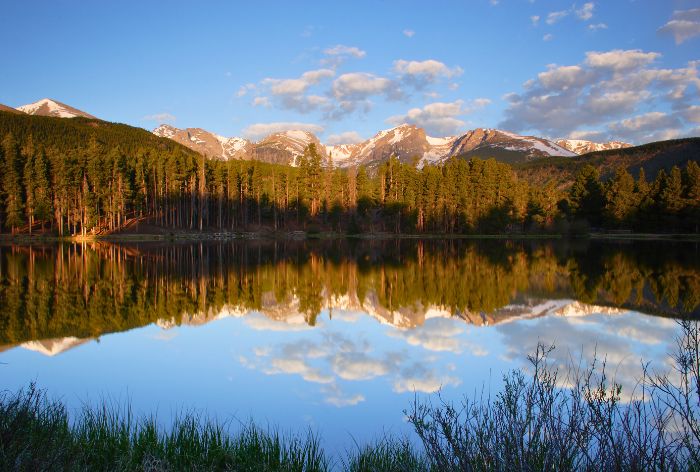
Sprague Lake at Sunrise / Tips for First-Time Visit to Rocky Mountain National Park
- Wildlife Photography
For wildlife photography, early morning and late afternoon are the best times to spot animals. Some of the best wildlife spots include Moraine Park, which is known for elk sightings, and Upper Beaver Meadows, where you might catch sight of bighorn sheep, mule deer, and other animals.
Camping at Rocky Mountain National Park
Rocky Mountain National Park offers a variety of camping experiences, from front-country campgrounds with easy access to trailheads to more remote backcountry campsites.
- Front-Country Campgrounds
These campgrounds are located near main roads and offer easy access to the park’s attractions, making them ideal for first-time visitors.
Moraine Park Campground is one of the most popular campgrounds in the park located in Moraine Park, a picturesque meadow with great views of the surrounding peaks.
The campground has 244 sites, including some that are accessible for RVs and tents. Reservable and first-come, first-served sites are available, but reservations are highly recommended during the peak summer months.
Aspenglen Campground is located near the park’s North Entrance, Aspenglen is a good choice for visitors who want to explore the western side of the park.
It has 52 sites, offering a combination of tented and RV sites. The campground is close to the Moraine Park area, and the Fall River Visitor Center is a short drive away, making it easy to access the park’s major attractions. It’s open year-round, though certain facilities may be limited in the off-season.
- Backcountry Camping
For those seeking a more rugged and isolated experience, backcountry camping offers the chance to immerse yourself fully in nature.
There are 26 backcountry campsites spread throughout the park, accessible only by hiking. Backcountry camping requires a permit, which you can obtain at one of the visitor centers.
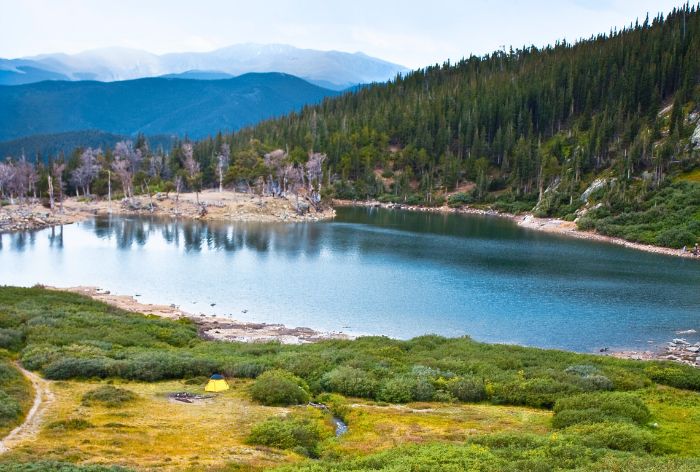
Camping in RMNP / Tips for First-Time Visit to Rocky Mountain National Park
Here Are Some More Ideas of Places to Visit in Colorado:
How to Visit Garden of the Gods, Colorado (7 Best Things You Can’t Miss)
24 Best Stops on Rim Rock Drive in Colorado National Monument (Maps, Tips, Hikes)
How to Visit the Maroon Bells near Aspen, Colorado (+Hike to Crater Lake)
Perfect 5 Days in Rocky Mountain National Park (Hikes, Scenic Drives, Hidden Gems)
9 Best Hikes in the Bear Lake Corridor, Rocky Mountain National Park (Maps and Tips)
18 Best Stops on Trail Ridge Road in Rocky Mountain National Park
12 Best Stops and Hikes on Peak to Peak Scenic Byway in Colorado (Maps+Useful Tips)
14 Things You Can’t Miss on First Visit to Glenwood Springs, Colorado
2 DAYS in MESA VERDE National Park (Perfect Itinerary for First Visit)
23 Practical Tips for FIRST VISIT to MESA VERDE National Park
Did You Find Tips for First-Time Visit to Rocky Mountain National Park Useful?
Why Not Save It to Your Pinterest Board!


Now, It Is Your Turn, I Would Like to Hear Back from You!
Are you planning your trip to Colorado?
Please let me know!
Drop me a quick comment right below!
Click on any of the images below to get inspired!
